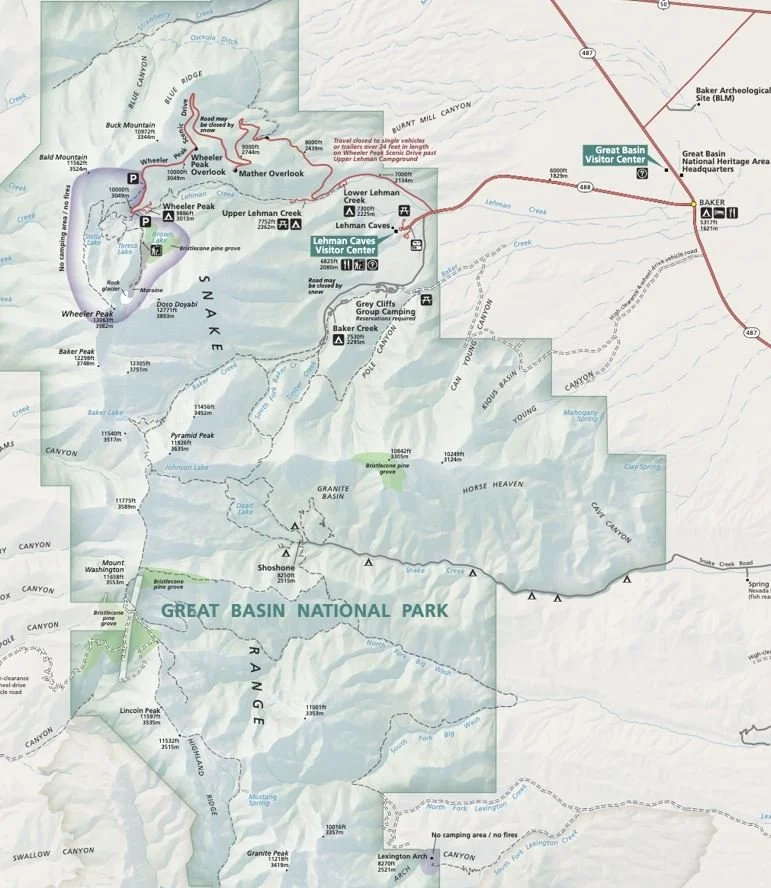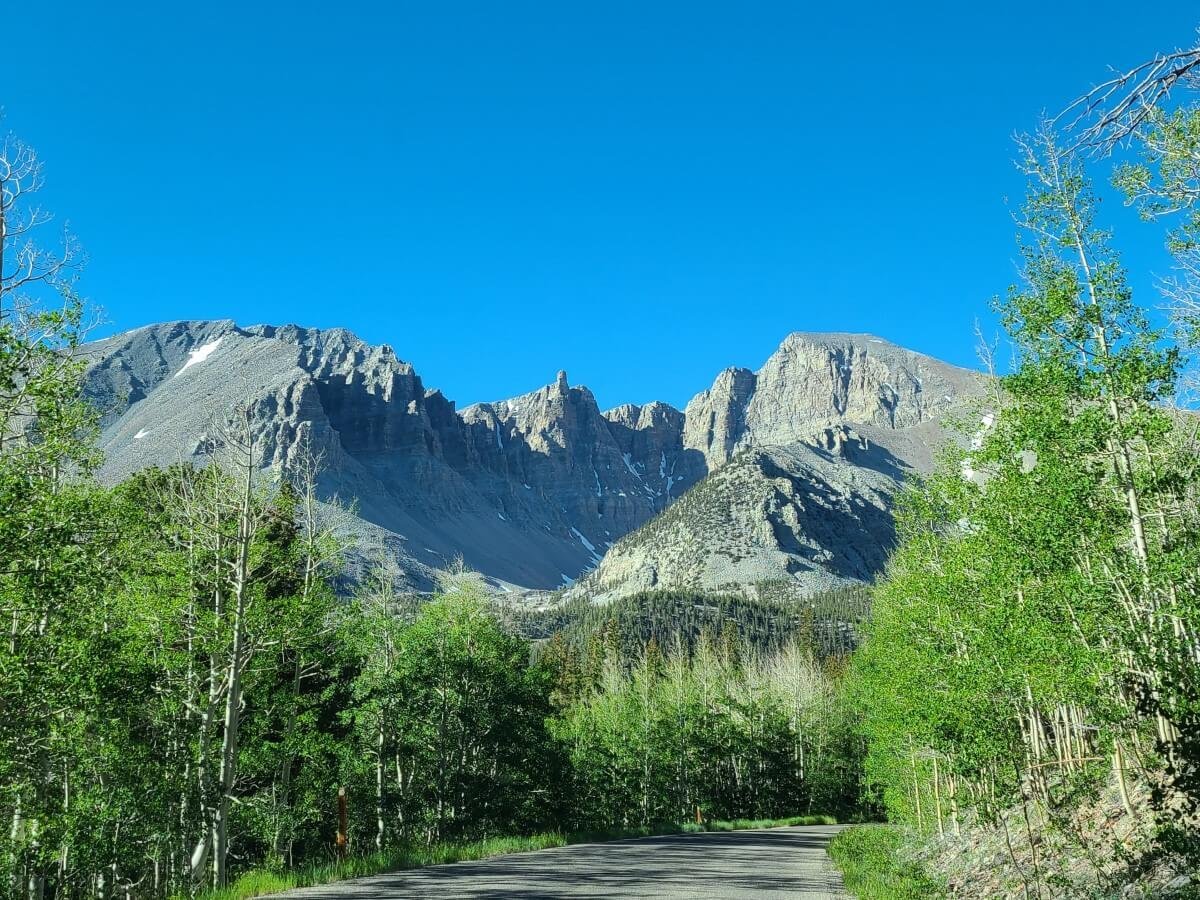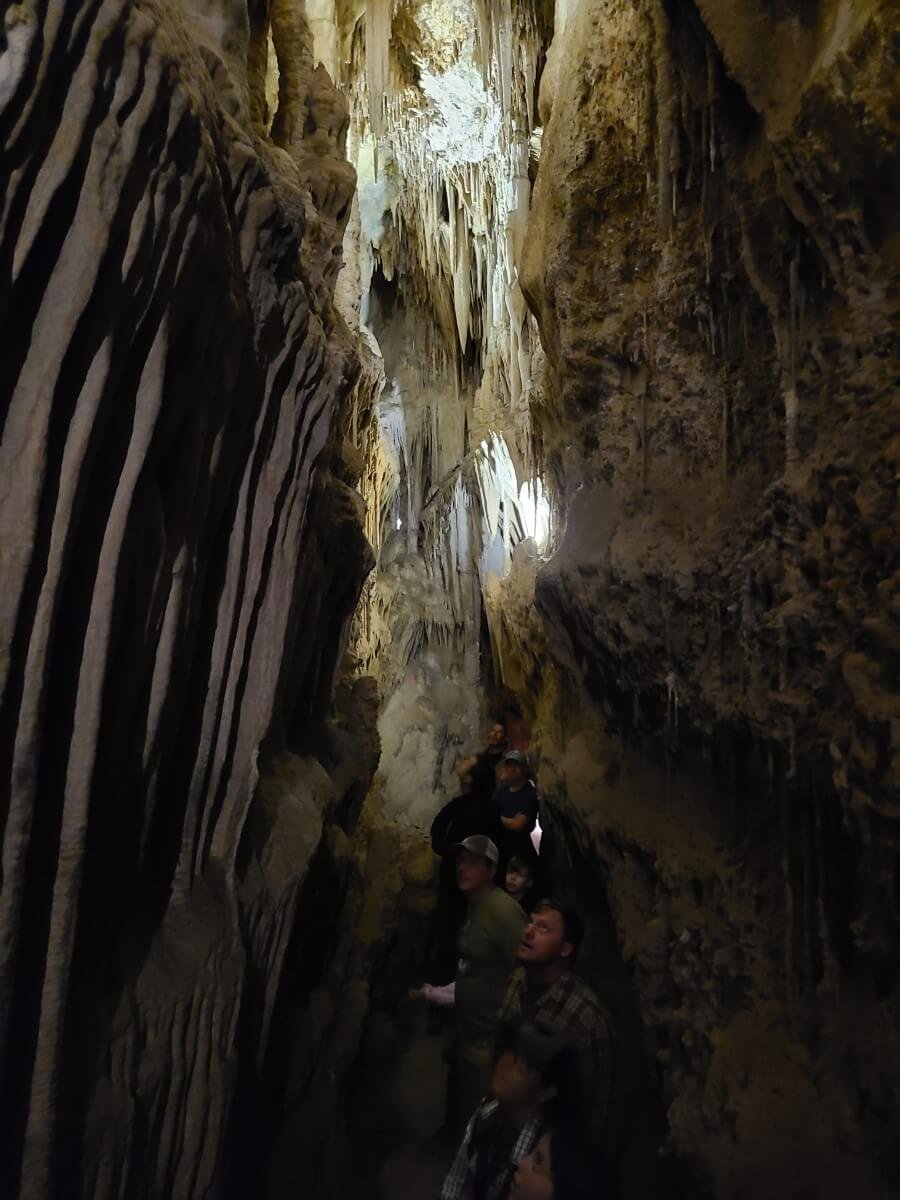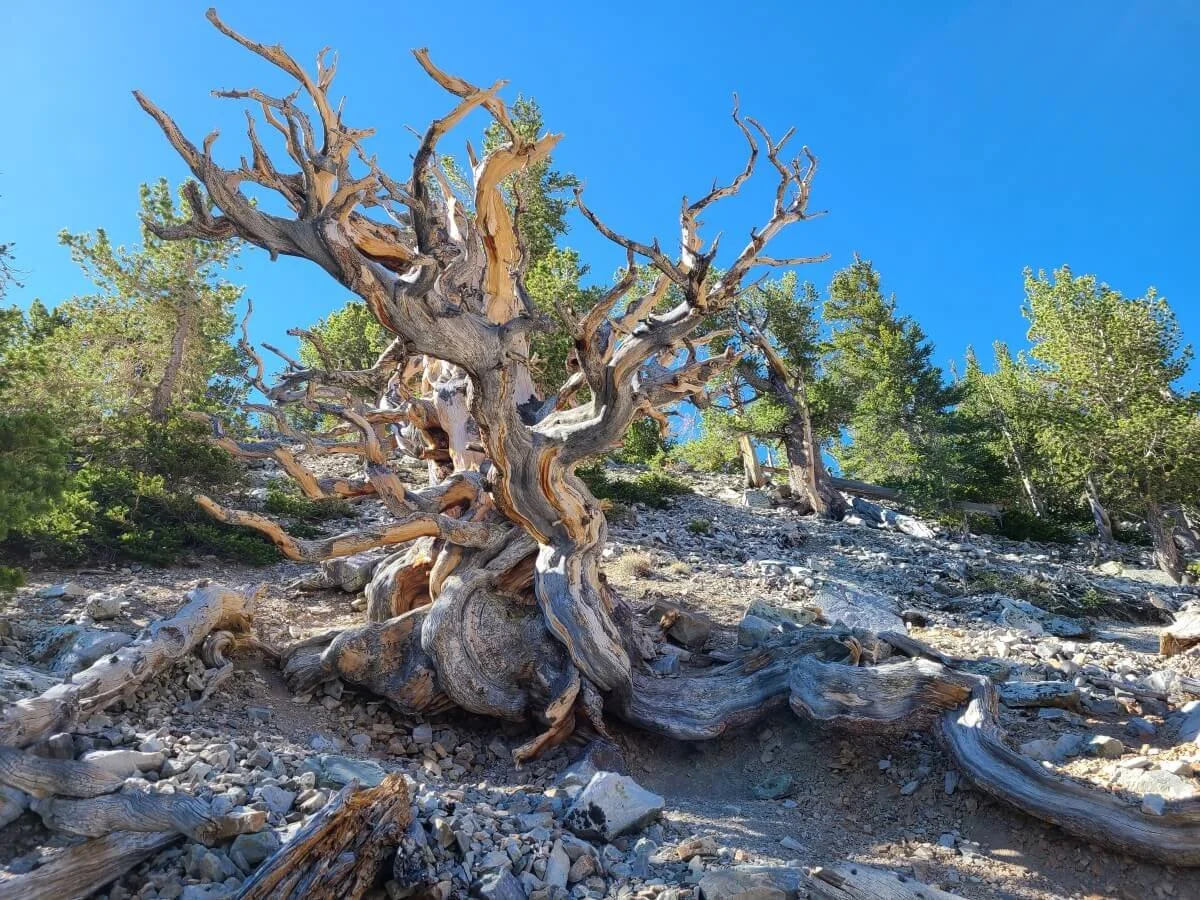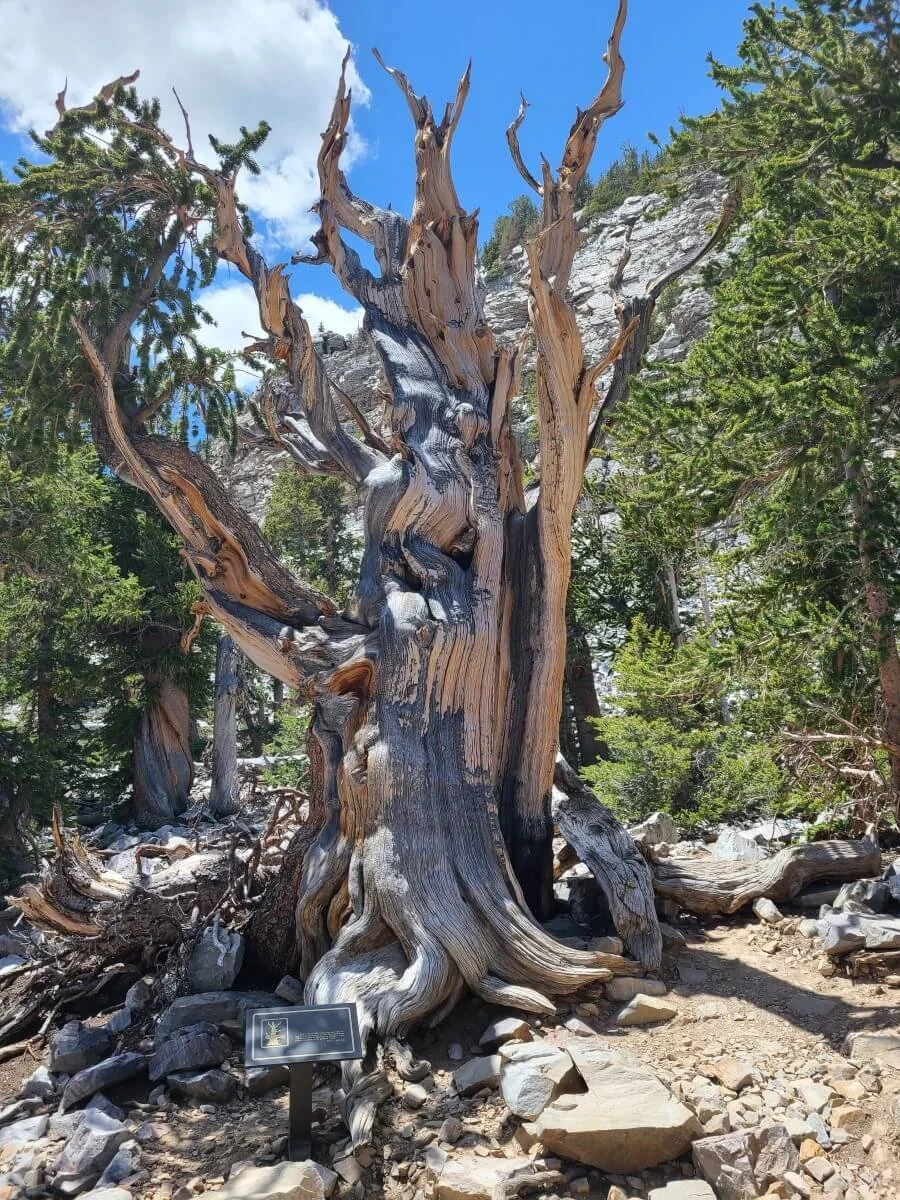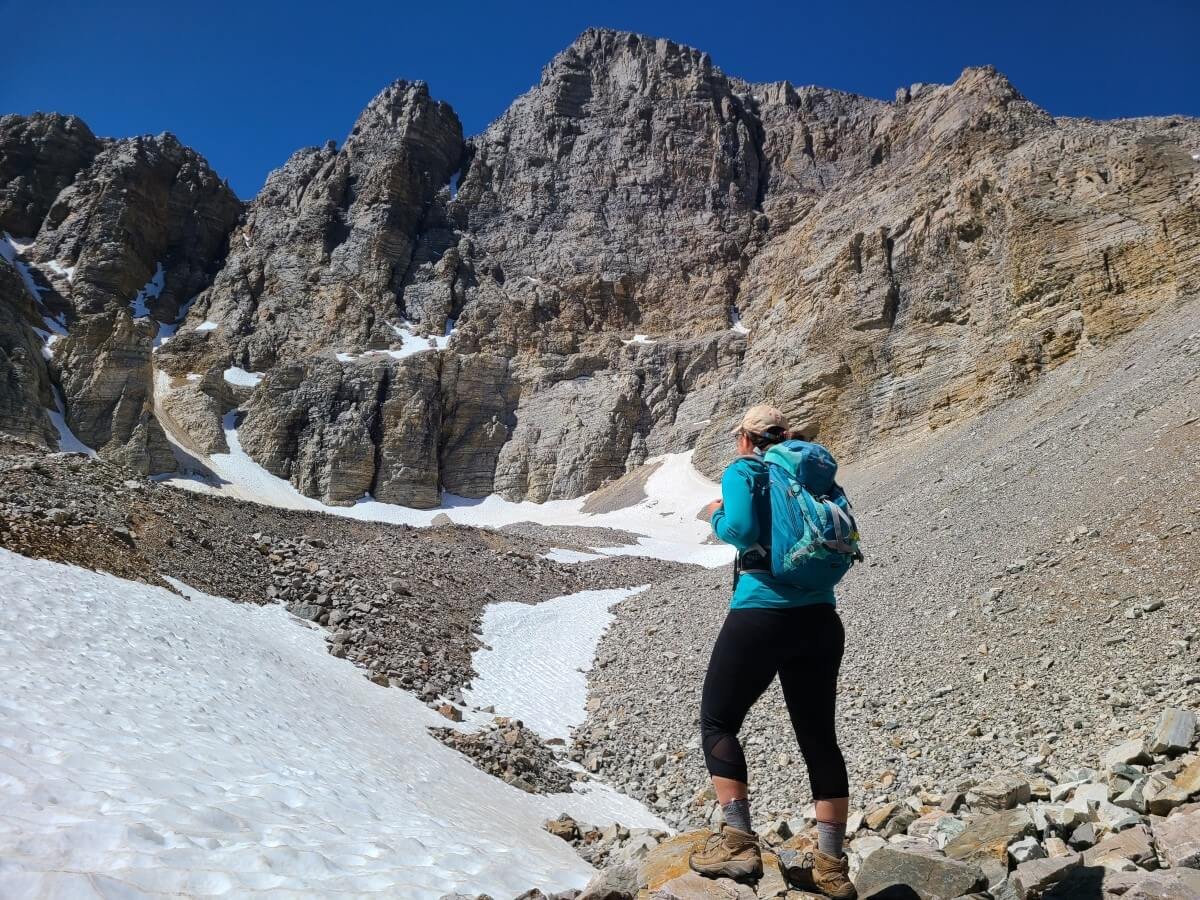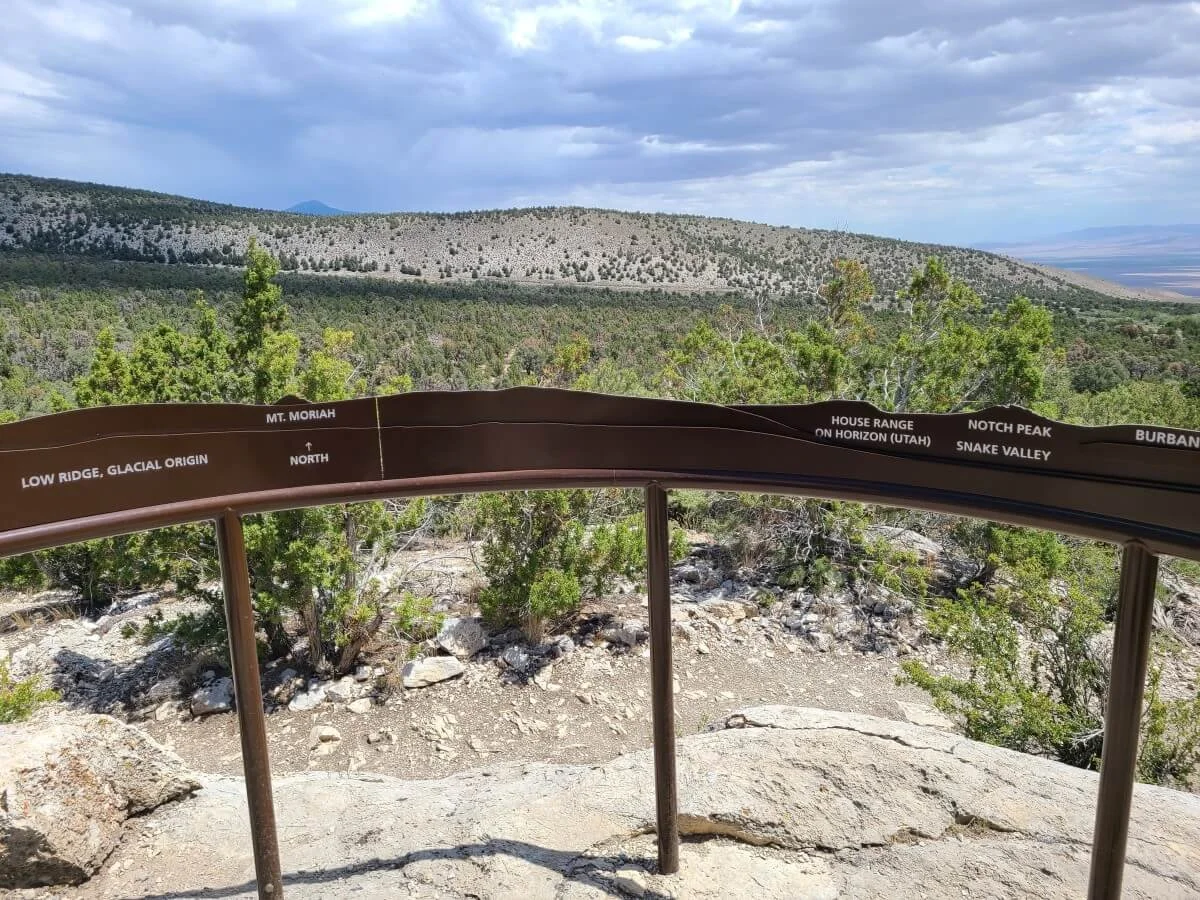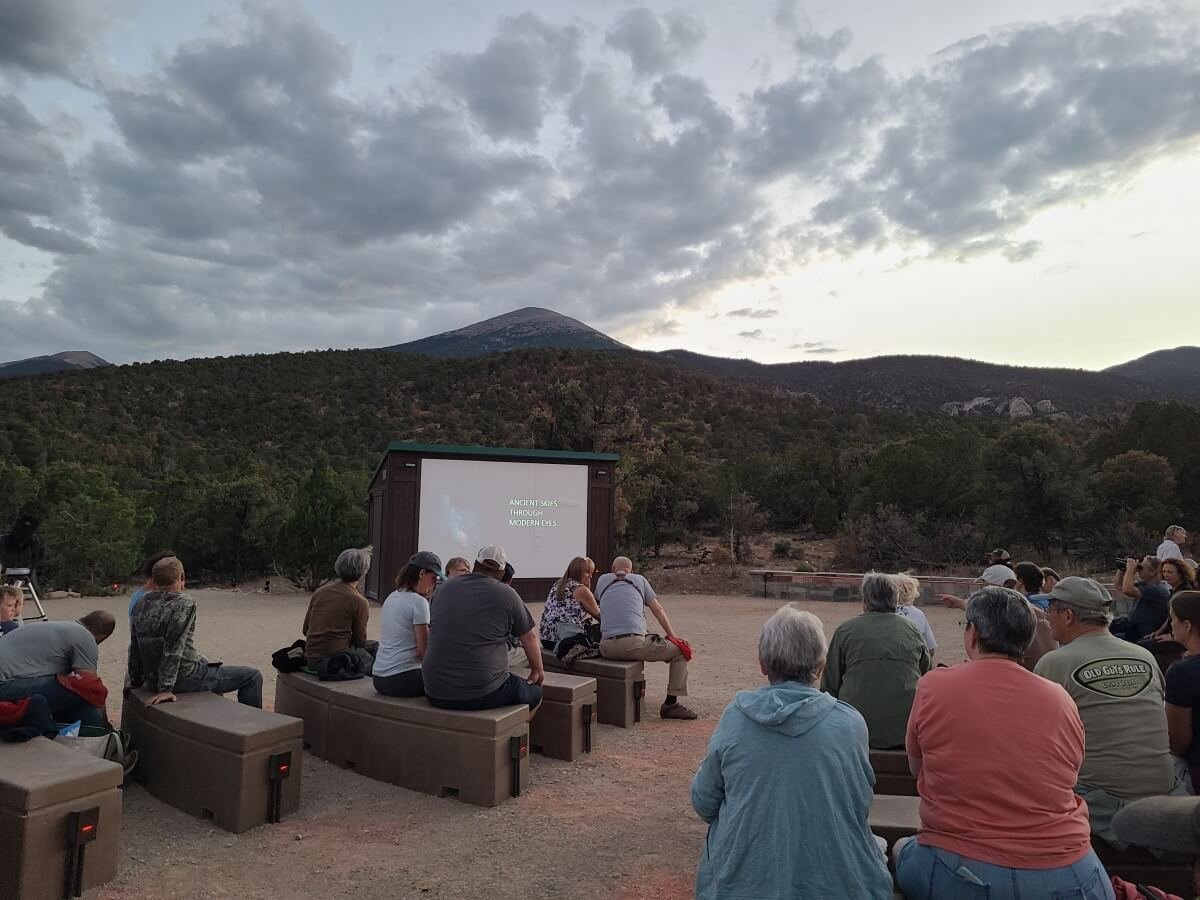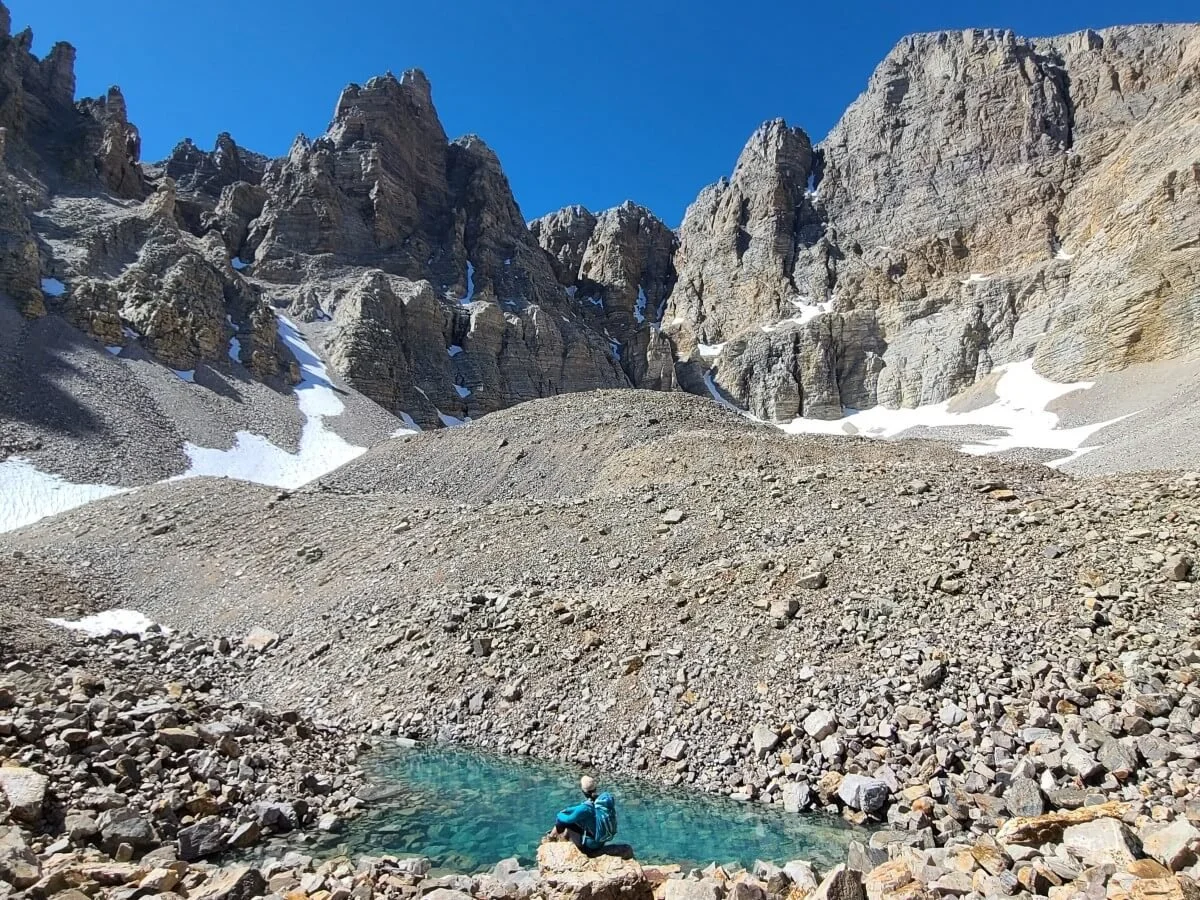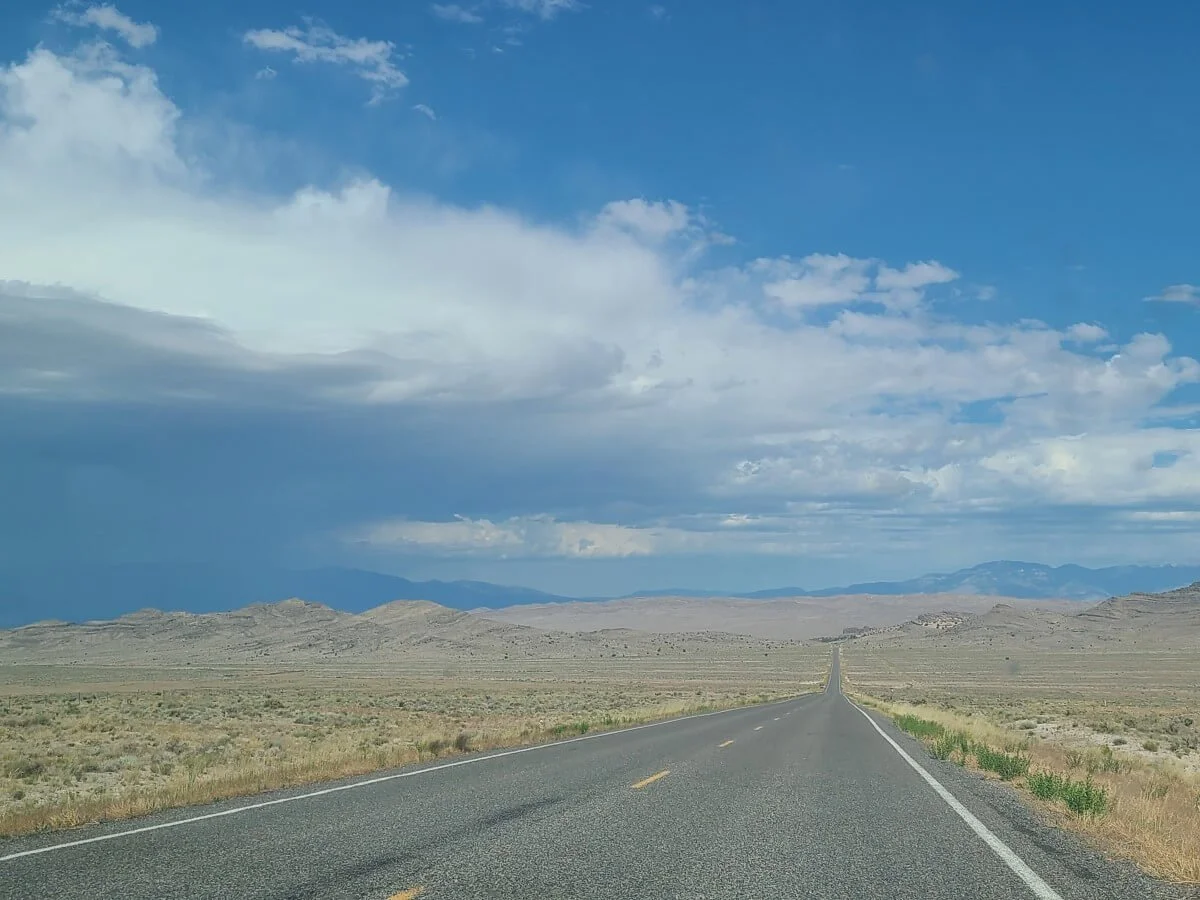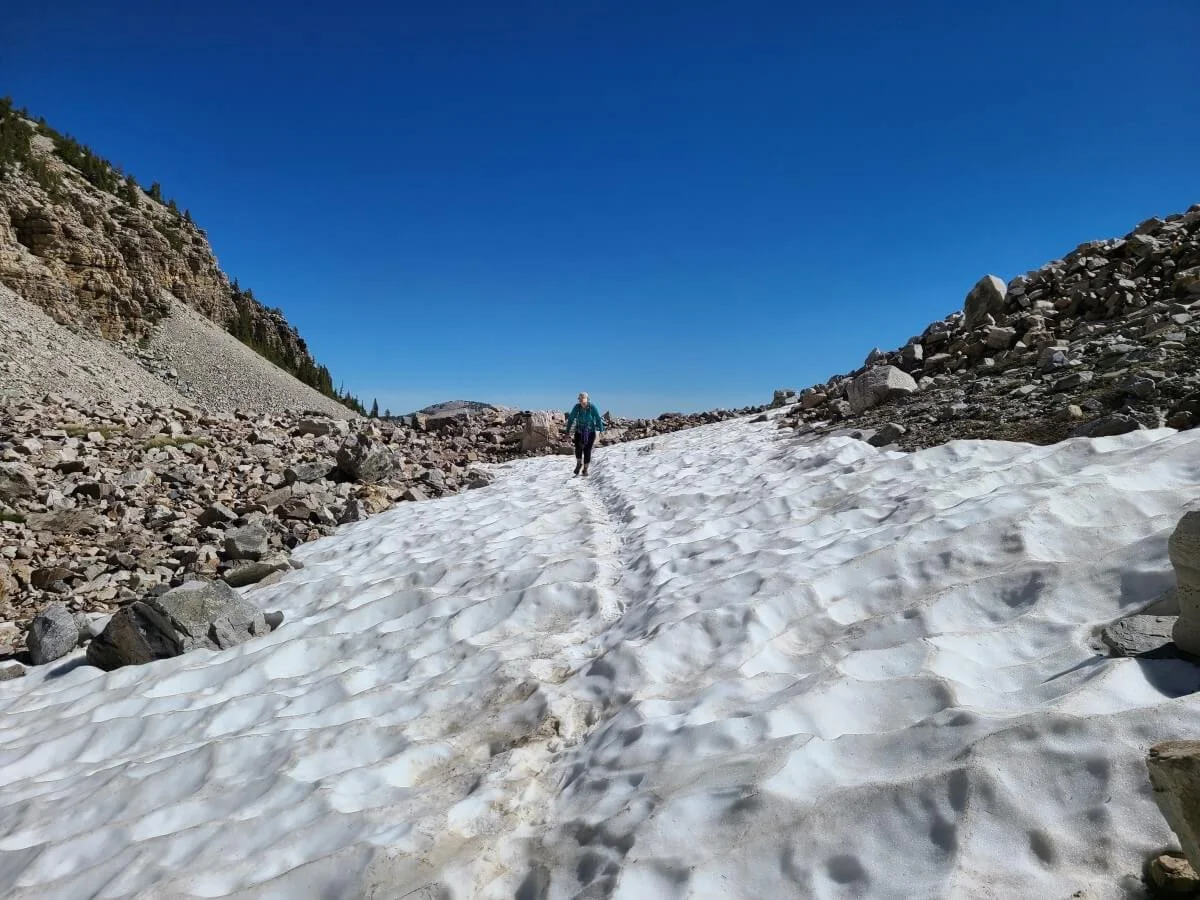10 Epic Things to Do in Great Basin National Park (Plus 1-3 day Great Basin Itinerary)
Wondering what there is to do in Great Basin National Park? In this guide, we’ll cover all the top sights in Great Basin, including best hikes, scenic drives, and more. Plus, we’ll give you one to three day Great Basin National Park itineraries to help you plan your time!
Great Basin National Park is one of the country’s most remote National Parks. Located at least four hours away from any major city, this park lies seemingly in the middle of nowhere, surrounded by the barren Great Basin Desert. In fact, to get to Great Basin National Park from regions west, like Reno and Northern California, you’ll have to drive Route 50, the transcontinental highway stretching between California and Maryland, but of which the nearly 400 mile portion stretching across Nevada has been named “The Loneliest Road in America”.
At this point, you might be asking yourself, “Well, what is there to do in Great Basin National Park? Is it even worth my time?”.
To be honest, we didn’t know much about Great Basin National Park before we visited. We knew it existed, but we never really knew when we would ever make it out there since it wasn’t really near anything else. But when we found ourselves on a road trip out west with some cancelled backpacking plans in Wyoming, we thought, “Now’s our chance!”, and we made a last-minute, rather large, detour and drove all the way out to Great Basin.
And, as you may have guessed, we are super glad we did! Great Basin National Park was a wonderful surprise. It’s not a huge park, but its diversity and beauty were totally unexpected. And, there are so many amazing things to do in Great Basin. You can drive from the desert floor to a beautiful alpine environment teeming with wildlife and alpine lakes, climb to the top of one of Nevada’s tallest peaks, explore underground caves, see a glacier, walk among the world’s oldest living organisms (hint: they’re trees!), and see the most amazing night skies you’ll probably ever see. And you really don’t need much time to do it all!
In this guide, we’ll go over all of these amazing things to do in Great Basin National Park. Plus, we’ll give you one to three day Great Basin National Park itineraries to help you plan your time and to make sure you see all of Great Basin’s top sights no matter how much time you have!
Let’s get to it!
In this Great Basin itinerary and guide:
Is Great Basin National Park Worth Visiting?
Spoiler alert: We think views like this make Great Basin worth visiting!
Because it’s kind of in the middle of nowhere, a lot of people end up wondering why they should visit Great Basin National Park in the first place. Is it worth my time? What does it have to offer?
A lot, actually! There are a few things that make Great Basin National Park so special…
First, Great Basin is home to the Bristlecone Pine, unusual looking trees that can live to almost 5,000 years, making them the oldest living species in the world! There are three groves in the park, and when we talk about the best things to do in Great Basin below, we’ll go over how you can visit the most accessible one!
Second, Great Basin is also home to Nevada’s one and only glacier! It’s tiny and barely hanging on from the effects of climate change, but it’s there. It’s called the Rock Glacier, and is found at the base of Wheeler Peak, and below, we’ll show you why hiking to the base of this glacier is one of our favorite things to do in Great Basin National Park!
Third, Great Basin is also home to Nevada’s longest cave, Lehman Caves. This cave system is known to be highly decorated with lots of unique and rare formations, and taking a tour of Lehman caves is definitely one of the best things to do in Great Basin.
Fourth, Great Basin is a dark sky park, meaning Great Basin is just as good at night as it is during the day! People come from all over to star gaze in Great Basin’s dark skies, and the park puts on several programs and events throughout the year for people to peep through telescopes and see distant planets, galaxies, and stars.
Finally, one of our favorite things about Great Basin is that, despite all these amazing things to do in Great Basin, the park still remains pretty crowd-free! Especially for those who want to hit the trails, Great Basin’s hikes were, in our experience, virtually empty, so you can really enjoy some solitude out here…a rare find these days!
Have we piqued your interested yet?! Oh, and in case you were still wondering our answer to the question, Is Great Basin worth visiting?, our answer is a resounding “yes”! So, let’s get into the best things to do in Great Basin National Park now to help you plan your visit!
Things to Do in Great Basin National Park
From hiking to the top of one of the tallest peaks in Nevada, to exploring underground chambers, and everything in between, there are lots of amazing things to do in Great Basin National Park that will keep you busy for days. Here are some of Great Basin’s top sights and things to do!
Great Basin National Park map
But first! Here is a map of Great Basin to help you visualize where all the best things to do in Great Basin are located. Be sure to refer back to this as we go through the list!
This map of Great Basin is taken from the National Park Service brochure and shows all of the best things to do in Great Basin that we mention below
As you can see, the park is pretty simple, with one main paved road which houses most of the best things to do in Great Basin National Park, so it’s a pretty easy park to figure out and navigate!
1. Drive the Wheeler Peak Scenic Drive
Mountain views from the Wheeler Peak Scenic Drive in Great Basin National Park
One of the easiest and best things you can do in Great Basin National Park is to drive the Wheeler Peak Scenic Drive. This is a 12 mile paved road that starts just before the Lehman Caves Visitor Center at 6,800 feet and climbs about 3,000 feet in elevation, topping out at 10,000 feet before ending at the Wheeler Peak campground.
Along the way, you’ll drive from barren desert up to a subalpine forests, and it’s truly incredible to see the landscape drastically shift as you go. Towards the end of the scenic drive, there are a few viewpoints (Mather Overlook and Wheeler Peak Overlook) you can stop at to get a good look at Wheeler Peak, the tallest point in the park that dominates the skyline here, and its surrounding cirque, which houses Rock Glacier, Nevada’s only glacier. By the time you’ve reached the top of this scenic route, you’ll be well over 4,000 feet higher than where you entered the park in Baker, which sits at just 5,300 feet, so enjoy the views from up here!
View of Wheeler Peak and the Rock Glacier from Mather Overlook in Great Basin National Park
The great thing about driving the Wheeler Peak Scenic Drive is that it’s fairly short and such an easy and quick thing to do in Great Basin that it can be done no matter how long you have to spend in the park.
Plus, many of the other things to do in Great Basin National Park that we mention below are also located along this road, particularly at the end, so chances are you definitely will be driving this scenic route if you visit Great Basin!
Here are some commonly asked questions regarding the Wheeler Peak Scenic Drive:
Is the Wheeler Peak Scenic Drive scary?
This Great Basin scenic drive winds its way up through a series of twists, turns, and switchbacks as it hugs the side of the Snake Mountains. The road is a typical mountain road and can get narrow, with some exposure along one side at times, however, it’s not scary. Often, the cliffs are shrouded in vegetation, so it doesn’t really seem like you are driving along an exposed edge. We never felt unsafe or uncomfortable while on this road. Just be sure to take it slow. Also, especially at dusk, keep your eyes out for wildlife like jackrabbits which may dart across the road!
A typical stretch of road on the Wheeler Peak Scenic Drive in Great Basin
Also note that because the road is particularly twisty, longer vehicles aren’t allowed past the Upper Lehman Creek Campground portion of the road, so keep that in mind when you visit!
How long does it take to drive the Wheeler Peak Scenic Drive?
At 12 miles, this scenic drive is pretty short, but it has an appropriately slow speed limit! Going slowly, and stopping at the two viewpoints along the way, the Wheeler Peak Scenic Drive should take you about 30 minutes or so to get to the top. To get back down it will take slightly less time if you aren’t stopping at the viewpoints again.
Of course, if you plan on doing any of the park’s popular hiking trails found along this road, then driving the Wheeler Peak Scenic Drive will be an all-day affair!
When is the Wheeler Peak Scenic Drive open?
The Wheeler Peak Scenic Drive is open year round up to Upper Lehman Campground. Beyond this campground (the last 9 miles of the drive), the road is closed in the winter due to high snowfall. It typically opens at the end of May and closes sometime in October, but be sure to check yearly conditions for exact dates. In 2023, because of the unusually high snowfall experienced in the park, this road is not projected to open until July 1st!
In the winter, you are welcome to ski and snowshoe the road and trails if you are experienced.
2. Tour Lehman Cave
Touring Lehman Caves is one of the best things to do in Great Basin National Park
Before we made the impromptu decision to visit Great Basin National Park, we had no idea that it had a whole cave system to explore! But heading underground to check out Lehman Caves is definitely one of the most popular things to do in Great Basin National Park.
Lehman Caves is over 2 miles long and a small portion is open to visitors, but you cannot visit independently and you absolutely need a ranger-guided tour to visit Lehman Caves. But it’s for the best, as you will learn a ton from the ranger about the cave and its significance, its history, how it formed, its preservation, and all the different cave formations. Speaking of which…
Lehman Caves is such a great cave to visit because it is very highly decorated, meaning it has a ton of unique and interesting formations. Aside from the usual stalagmites and stalactites found in many caves, Lehman Caves’ chambers are also filled with unusual and more rare formations, too, and funnily enough, many of them are nicknamed after food items…like cave turnips, cave bacon, and cave popcorn!
You’ll be walking through some tight passageways on a Lehman Cave Tour!
Our guide pointing out some Cave Bacon!
A particularly famous cave formation in Lehman Caves is known as a cave shield, which looks kind of a like a jellyfish hanging from the ceiling. Although there are about 500 of them in Lehman Cave, the most famous is the elaborate Parachute Shield, found in the Grand Palace chamber.
The jellyfish-like cave shield
Lehman Cave has tons of them!
There are currently three tours of Lehman Caves that you can choose from:
Grand Palace Tour: This is the longest tour of Lehman Caves. You’ll walk though about 0.6 miles of the cave over the course of 90 minutes, and go through several different chambers, including the Music Room, Lodge Room, Inscription Room, and the Grand Palace which houses the famous Parachute Shield.
Lodge Room Tour: This is a one hour long tour through a half mile of the cave where you will explore the Music Room, Lodge Room, and Gothic Palace.
Gothic Palace Tour: This is a quick peek into the cave. You’ll visit a highly decorated chamber, the Gothic Palace. This tour lasts a half hour and goes about a quarter mile through the cave.
Here are some commonly asked questions about taking a tour of Lehman Caves in Great Basin National Park:
How do I get tickets to tour Lehman Caves in Great Basin?
Lehman Cave tour tickets have to be reserved in advance. Tickets become available to reserve 30 days in advance of the tour date on recreation.gov. Since touring Lehman Caves is such a popular thing to do in Great Basin National Park, tickets can sell out pretty quickly, so you’ll want to try to snag some as soon as you can. If you find that your date is already sold out, keep checking! Cancellations do happen and those tickets will get released back into the system. This is how we got our tickets! Since we made such a last minute decision to visit Great Basin, we were checking online for tickets just a few days in advance, and of course, tickets were sold out. I kept checking though in the following days, and we were able to snag a pair of tickets the evening before for the Gothic Palace Tour.
If that still doesn’t work, as a last ditch effort, you can show up to the Lehman Caves Visitor Center and try to get tickets to a same-day tour, but this is pretty rare to get. That said, we were able to get a ticket that way kind of accidentally! After our Gothic Palace Tour, we were hanging around the visitor center checking out exhibits and the store, and we just happened to hear a ranger on the phone with a person who was cancelling their Grand Palace Tour for that afternoon. We weren’t planning on doing another tour, but we liked the Gothic Palace one so much that we decided to go for it. We walked up to the ranger, asked about the tickets, and as it turns out there was one now available, so we took it, and about an hour later Kevin was on the Grand Palace Tour!
Certainly don’t rely on this method of getting Lehman Cave tour tickets, but it’s there as a last-ditch option.
How much does a Lehman Cave tour cost?
The cost of the Lehman Caves tour varies. The Gothic Palace Tour is only $5 per person, while the Lodge Room Tour is $12 and the Grand Palace Tour is $15 (all prices are less for children and those with Golden Age and Access Passes).
Which Lehman Caves tour should you take?
No matter which Lehman Caves tour you take, you’ll be able to see all the features that make the cave famous, so it really just comes down to how much time you have, how long you can stand being in tight underground spaces, and how much money you want to spend. When we visited, only the Gothic Palace Tour and Grand Palace Tours were available, and we experienced both. We first went on just the short 30 minute Gothic Palace Tour and even on this short tour, we got to see all of the interesting formations (turnips, shields, bacon, popcorn, drapery, heliotites, stalactites, stalagmites, etc) and learned a ton from the ranger. In the longer Grand Palace Tour, Kevin was able to see a few more chambers, as well as see the famous Parachute Shield, plus got to learn a few more interesting factoids about the cave. He said it was worth taking even after being going on the shorter Gothic Palace Tour just to see more of the cave.
In all tours, the ranger will also have everyone turn off their lights so that you can experience the complete darkness of the cave, which is always an unsettling but fun experience no matter how many caves we’ve been in throughout the years! Plus, in this cave, it will allow you to see glowing calcite scattered through the cave walls!
What time of year can I tour Lehman Caves in Great Basin?
Cave tours are offered all year except for certain holidays, making this a great thing to do in Great Basin even if you come in the cold winter months! Be sure to check the schedules of the Lehman Cave tours, as they change based on the season.
What if I can’t tour Lehman Caves?
A display of Lehman Caves in the visitor center at Great Basin
Maybe you couldn’t get a ticket. Maybe you’re just claustrophobic and can’t handle tight spaces. We get it! You can still kind of experience Lehman Caves, though, in a different way.
The park offers “virtual tours” of Lehman Caves. Also, the Lehman Caves Visitor Center has some really great exhibits that make you almost feel like you are actually standing in the cave itself, and give all the information you’ll ever need to know.
3. Visit alpine lakes on the Alpine Lakes Loop hike
The Alpine Lakes Loop is a must-do in Great Basin National Park!
Our personal favorite thing to do in Great Basin National Park was to hike, and the Alpine Lakes Loop is a great trail to tackle. It’s pretty short and easy, but takes you into a beautiful subalpine world with meadows, mountain views, and alpine lakes that will have you feeling completely transported from the desert basin 4,000 feet below at the park’s entrance!
This Great Basin hike begins at the end of the Wheeler Peak Scenic Drive, at the Bristlecone parking lot (just before the Wheeler Peak Campground).
Shortly after you begin, you’ll come to a split in the trail where you can choose to go either clockwise or counterclockwise around the loop. It doesn’t really matter which way you go. The entire trail is easy to follow, and there’s nothing too challenging. If going clockwise like we did, you’ll come to Teresa Lake first, followed by the picturesque Stella Lake, both with views of Wheeler Peak dominating the background.
The gorgeous Stella Lake on the Alpine Lakes Loop in Great Basin National Park
The total Alpine Lakes Loop is 2.7 miles with just over 400 feet of elevation gain, so you can enjoy some of the top sights of Great Basin without much work!
4. Stand among the world's oldest living species...the Bristlecone Pine
A crazy-looking Bristlecone Pine in Great Basin National Park
One of the more unique things to see in Great Basin National Park are the Bristlecone Pine Trees. And although you may be thinking, umm…it’s just a tree, I’m not that interested…what if we told you that these trees can live to almost 5,000 years old, making them the oldest living organisms on the planet? Pretty cool, huh?
To make them even cooler, these hardy trees are very interestingly shaped, often very stout and twisted and contorted into unique profiles , shaped by the hard conditions in which they live.
There are three groves of Bristlecone Pine in Great Basin, two of which are pretty remote and pretty much inaccessible. One grove, however, is quite accessible, and can be found along a trail at the end of the Wheeler Peak Scenic Drive.
The Bristlecone Pine Trail is a popular thing to do in Great Basin. It’s a relatively short hike at just 2.8 miles roundtrip and with a very gradual 500 feet of elevation gain. You’ll quickly hike from subalpine forest to rocky alpine terrain before hitting the small loop that brings you to several of these Bristlecone giants.
If you’re up for it, the trail continues past the Bristlecone Pine patch onto the next sight on our things to do in Great Basin list, or, you can simply turn around and head back to the parking lot.
5. See Nevada's only glacier
Hiking the Glacier Trail was our favorite thing to do in Great Basin National Park
Although relatively small in size thanks to the effects of global warming, the Rock Glacier that sits at the base of Wheeler Peak is still hanging on as the state’s only remaining glacier. Hiking to this glacier was actually our favorite thing to do in Great Basin National Park! This trail brought us into a completely alpine world that was hard to believe existed out here, and we felt like we were completely transported out of Nevada. We had no idea what to expect on this hike, and needless to say, we were very pleasantly surprised. And best of all, we enjoyed it in complete solitude.
This Great Basin hike starts where both the Alpine Lakes Loop and Bristlecone Grove trails begin, at the parking lot at the end of the Wheeler Peak Scenic Drive. You’ll actually hike the same trail to the Bristlecone Pine grove (making this an awesome 2 for 1 hike!) and continue past it across the glacial moraine, with epic views of both the glacier and the Wheeler Peak cirque.
Hiking to the Rock Glacier in Great Basin National Park
The Rock Glacier hike is on the longer side compared to the previous two hikes, at 4.8 miles with just over 1,000 feet of elevation gain, but it is totally worth it.
6. Climb Wheeler Peak
Catching views from the Wheeler Peak Summit is an epic thing to do in Great Basin!
If you’re up for a real challenge, then the best thing to do in Great Basin National Park is to climb that huge mountain that dominates the skyline…Wheeler Peak.
Starting at one of two trailheads at the end of the Wheeler Peak Scenic Drive, you’ll hike almost 9 miles roundtrip and climb over 3,000 feet to make it the summit of this 13,063 foot mountain. Be sure to come prepared for rough and rocky terrain, steep climbs, altitude, and windy conditions on this one! But the reward is amazing 360 degree views of Great Basin National Park and beyond, where you can see the stark transition from the rugged Snake Mountain range to the flat Great Basin desert beyond.
The steep rocky climb up to the Wheeler Peak summit in Great Basin
Plus, you can say that you’ve stood at the top of the highest peak in Nevada! Well, the highest peak that’s fully contained in Nevada. The true highest point, Boundary Peak, is not even 100 feet taller, and is shared with California (in fact, it’s often considered a subpeak of Montgomery Peak which is across the state border). So, if you want to say you stood on Nevada’s tallest peak after you’ve climbed Wheeler Peak, we won’t stop you!
7. Go hiking in Great Basin
So we know we’ve already covered a lot of great hikes in Great Basin so far in this list, but since they each showcase a different and unique feature of the park, they deserved their own spots. But there are plenty of other hikes in the park, and since hiking is our favorite thing to do in Great Basin National Park, and just in general, it’s worth mentioning on its own!
The Alpine Lakes Loop, the Bristlecone Pine and Glacier Trail, and the Wheeler Peak Trail are probably the most popular hikes in Great Basin. While they are still relatively crowd-free, choosing a different trail will get you even further off the beaten path.
One hike in particular that we had our eye on but just didn’t have time for was the Baker-Johnson Lakes Loop trail. This trail is one of the more strenuous in the part, clocking in at almost 12 miles and over 3,200 feet of elevation gain, but it will take you to two remote alpine lakes and up and over a scenic pass in between. This hike is found at the end of Baker Creek Road, which is unpaved but graded and doable with a regular 2 wheel drive vehicle under good conditions.
The Osceola Ditch Trail is another hike found off of the Wheeler Peak Scenic Drive. It can be done as a long point-to-point hike or you can do an out and back hike of whatever distance you’d like. To get to the Osceola Ditch, which was made by gold miners in the late 1800s, its just a third of a mile hike down the trail. Check out this informational brochure for information on how far you’ll have to hike to get to this historic landmark and read about its history.
If you’re looking for some easier strolls in the park, the short Mountain View Nature Trail right behind the Lehman Caves Visitor Center is a good option. At one point along the trail, you’ll come across a viewing scope which labels the distant mountains.
The Mountain View Nature Trail in Great Basin National Park
The Sky Island Forest Trail is another very short and easy trail, found at the parking lot at the end of the Wheeler Peak Scenic Drive. This is an interpretive trail through the subalpine forest.
8. Go stargazing in Great Basin National Park
Being in the middle of nowhere certainly has its perks, and one of those perks is having one of the darkest night skies in the country! Great Basin is one of several International Dark Sky Parks, meaning you can experience some of the best stargazing here, making the nights at Great Basin just as good as the days.
If you can, we highly recommend spending at least a night in the park, because stargazing is definitely one of the best things to do in Great Basin. We can say from personal experience that we saw one of the clearest and star-iest (this should definitely be a real word…) Milky Ways we had ever seen.
There are a few different ways you can experience the night skies in Great Basin.
Astronomy Programs at Great Basin
Waiting for the Astronomy Program to start in Great Basin
On regular nights throughout the summer, the park hosts an amazing astronomy program at the amphitheater near the Lehman Caves Visitor Center. These programs are 100% free and don’t even require a reservation! Just be sure to check the park calendar to know what days and times they run, as they can change throughout the year depending on when the sun sets. When we were there in June, the program started at 8:30 pm, just to give you an idea.
Even though there are no reservations, you will want to get there a bit early. Because these astronomy programs are such a popular thing to do in Great Basin, the small parking lot at the Lehman Caves Visitor Center fills up fast, and when it does, they will start turning cars away. We got there about 20 minutes early and the lot was quickly filling up…there ended up being over 150 people at the program!
The program starts off with a ranger talk about astronomy in the park, and then they break out the telescopes! When we were there, they had three scopes all set up on a specific star cluster or distant galaxy, and in a very organized fashion they had everyone join in on one of the three lines to take a peek. Once everyone had a chance to look through the scope, they would focus the scopes on something else and have every one cycle through again. We were able to see 3 or 4 different things this way, and it was pretty cool! The whole event lasted about 2 hours.
Do your own stargazing in Great Basin
If you can’t make it to a program, then stargazing in Great Basin National Park on your own is still amazing! Just find an open space and look up…easy as that! (The park also recommends bringing a pair of binoculars, which will help you seen even more.)
We actually enjoyed the stargazing in the amphitheater during the astronomy program so much that we decided to go back to the amphitheater again the following night, even though there was no program being held that evening. Just seeing the Milky Way stretch across the sky from there is amazing on its own. But to our surprise, when we got there, there were some people with telescopes set up who happily let us join in on their fun and pointed out a bunch of stuff for us! It turns out a lot of amateur astronomists come here to look through their scopes and study and track the stars and planets, so if you head to the amphitheater on an off-night, you might still get to look through a telescope.
Come to the Astronomy Festival in Great Basin National Park
Each year Great Basin holds an Astronomy Festival with three straight days dedicated to everything stars and filled with talks, workshops, tours, and telescope viewing. This year, the festival is September 14th-16th. We didn’t have the chance to go to this festival in Great Basin, but we have gone to one in Sequoia National Park and it is well worth going to.
Lehman Caves Visitor Center sun viewing
If you can’t stay for the night programs, then you can still stargaze during the day by looking at the closest star to us- the Sun! Often, you’ll see a ranger behind the Lehman Caves Visitor Center with a scope set up happily letting people take a look.
Looking through a telescope in Great Basin National Park!
9. Get off the beaten path in Great Basin
While the Wheeler Peak Scenic Drive is the most traveled road in the park and has many of the top sights in Great Basin National Park, there are a few other roads in the park that will get you a bit more off the beaten path.
There are four other roads, all of which are gravel (Baker Creek Road, Strawberry Creek Road, Snake Creek Road, and Lexington Creek Road). The park recommends having high clearance for each of them, but for Lexington Creek Road in particular, it is recommended to a have high clearance 4 wheel drive vehicle. Each of these roads leads to various off the beaten path hikes. One in particular is the Lexington Arch Trail, which leads to a tall limestone arch. We haven’t hiked here yet but it does look like a really neat place and you’re likely to have it all to yourself. Just be aware of road conditions of the Lexington Creek Road, as recent damage has made the last mile or so unpassable, which will add some time and distance to your hike.
10. Learn the history of the area
If you’re more of a history buff, then there are a few things to do in and near Great Basin for you. In the very small nearby town of Baker, there is an excavated site known as the Baker Archeology Site, a remnant of the Fremont Indians who once occupied the area. You can also check out the nearby Great Basin Visitor Center right in Baker to learn more about the history of this ancient culture.
In Great Basin itself, there is also evidence of the Fremont people in the form of pictographs. These can be found at Upper Pictograph Cave. This cave is located up Baker Creek Road, right near the Grey Cliffs Campground. We actually didn’t know about this cave until it was too late and we had left the park (womp womp), but we have seen pictographs made by the Fremont Indians in other parks, such as in Capitol Reef and at Dinosaur National Monument, and they are pretty neat!
Great Basin National Park Itineraries
Now that you know all the amazing things to do in Great Basin National Park, let’s get into how to plan your time so you can make sure to see all of Great Basin’s top sights!
How many days should I spend at Great Basin National Park?
One of the really great things about this park is that you really don’t need a whole lot of time to see most of the best places. You can see most of the top sights in Great Basin National Park in just a day!
Of course, there will always be more to do if you have more time, and we think two to three days in Great Basin National Park is a good amount of time to fully experience the park without feeling rushed, and also to really make the most of your time here, since it takes a bit of effort to get all the way out here!
Below we give suggestions for one, two, and three days in Great Basin National Park.
How to spend one day at Great Basin National Park
In one day in Great Basin, you can actually see a lot!
If you only have one day in Great Basin National Park, then no problem…you’ll still be able to accomplish many of the best things to do in Great Basin, but it will be a busy day. Here’s how we’d do it.
Start the day by visiting the Lehman Caves Visitor Center. Check out the exhibits, see if there is any telescope viewing outside, and take a morning cave tour. If you have some time, do the short interpretive Mountain View Nature Trail right outside of the visitor center.
Drive the Wheeler Peak Scenic Drive, stopping at the various viewpoints along the way.
Pick a hike. At the end of the Wheeler Peak Scenic Drive are three popular Great Basin hikes: the Bristlecone Trail, the Glacier Trail, and the Alpine Lakes Loop. If you can’t choose which one you want to do, then do all three! It’s easy to combine all three into one larger loop so you get to see all of Great Basin’s best sights in one hike. Check out our Great Basin hiking guide to see how to do it!
Head into Baker for dinner and/or visit the Great Basin Visitor Center or Baker Archeological Site. It will be getting close to dinner time, and there are limited options in the park (a seasonal café at the Lehman Caves Visitor Center). There will also be limited options in Baker, but out here you can also stop at the other visitor center or check out the nearby archeological site to learn a bit more about the cultural history of the area before heading out to dinner.
Stargaze. Even if you don’t plan on spending the night inside the park, we recommend hanging out for some stargazing if possible. Even if there is no astronomy program going on the night you’re there, just head over to the amphitheater and look up, and if you’re lucky, there may be some amateur astronomists hanging out there who are happy to share their scope.
Alternative one day Great Basin National Park itinerary:
If you are really set on hiking Wheeler Peak, it’s possible, but it will take up most of the day. Make sure to start early to both avoid afternoon storms, but also to leave time in the day for other things, like a cave tour (be sure to reserve a tour for the latest time slot possible…usually 3 pm in the summer months). After, be sure to stick around for some stargazing.
2-3 day Great Basin National Parkk itineraries
With two or three days in Great Basin, you’ll have plenty of time for longer hikes, like this one to Wheeler Peak
We think that having a little extra time in the park is ideal to really make the most of your time here.
On the first day in Great Basin, we recommend following the one day Great Basin itinerary above, visiting the cave, doing the hike to the Bristlecone Pines, glacier, and alpine lakes, and ending with stargazing at night.
On the second day in Great Basin, head up Wheeler Peak. Take the afternoon to relax at camp after a busy day and a half, or check out Pictograph Cave. Take advantage of spending the night here and stargaze again at the amphitheater.
On the third day in Great Basin, if you’re up for more hiking, we recommend either the Baker Johnson Lakes Loop Trail or Lexington Arch (if you have the appropriate vehicle). If you’ve had enough hiking, spend some time learning about the area’s history at the Great Basin Visitor Center and the Baker Archeological Site in Baker.
How to Get to Great Basin National Park
Great Basin National Park lies in eastern Nevada, right before the border with Utah, in the middle of the Great Basin desert. Getting here requires a bit of effort since it is so remote.
The closest major airports are in Las Vegas (4.5 hours away) and Salt Lake City (3.5 hours away). There are a few closer smaller regional airports but they will be harder to fly into and you probably can’t rent a car from them. And you’ll want a rental car, as there is no public transportation to or in Great Basin National Park.
If you’re driving, expect a long monotonous car ride! Especially if you’re coming from regions west, like Northern California or Reno, you’ll get to drive across “the loneliest road in America”. Make sure you’re stocked up on food, water, and gas before you set out!
The long road to get to Great Basin National Park!
You might even see dust tornadoes on the drive to Great Basin!
Where to Stay Near Great Basin National Park
The best option for staying near Great Basin is to stay right in the park, and the only option for staying in the park is camping.
Camping in Great Basin National Park
The Wheeler Peak Campground in Great Basin- can you see our tiny tent?
Great Basin has five developed campgrounds that each cost $20 per night: Lower Lehman, Upper Lehman, Wheeler Peak (all on Wheeler Peak Scenic Drive), Grey Cliffs, and Baker Creek (both on Baker Creek Road). We stayed at three of these, and loved all of them. The sites were well spaced out and pretty private, and the campgrounds were very quiet and peaceful at night. We would say the best one to stay at is the Wheeler Peak Campground if you’re looking to do a lot of the best hikes in Great Basin, as you can start the Alpine Lakes Loop, Glacier Trail, Bristlecone Trail, and the Wheeler Peak hike all right from the campground, allowing you to sleep in a bit later and not worry about parking. If you aren’t so concerned about hiking and are more interested in spending your time down by the Lehman Caves Visitor Center doing cave tours and stargazing, then any of the other campgrounds would be better for proximity.
All of these campgrounds have vault toilets, and no showers or hookups of any kind. Sometimes, there may not be water available either. When we camped in Great Basin, water was not available in any of the campgrounds and we would have to do runs to the Lehman Caves Visitor Center to fill up (be sure to have a big water jug or container for stocking up!).
Do you need reservations to camp in Great Basin National Park?
Currently, three of the five developed campgrounds in Great Basin require reservations from Memorial Day through to mid-September or October (check for exact dates): Upper Lehman Campground, Wheeler Peak Campground, and Grey Cliffs Campground. Normally, Lower Lehman Campground also requires reservations, but this year, they do not require them due to ongoing construction in the campground.
Reservations are made on recreation.gov up to one month in advance. It’s common for these sites to fill up in the summer season, so be sure to book as soon as you can. Since we decided to go to Great Basin on a whim last minute, we were checking recreation.gov only a few days in advance. Luckily, there were random open spots for two of the three nights that we planned on staying in the park, likely due to last minute cancellations, so we snagged those. To get our last night, we kept checking recreation.gov religiously, and eventually a spot opened up, so we were able to spend all three nights right in the park. To do that, though, we had to be very flexible, and spend each night in a different campground. We stayed at Lower Lehman, Upper Lehman, and Wheeler Peak. It was kind of a pain having to move around each night, but we could also time our activities conveniently around where we were staying each night, so it wasn’t too big of a hassle.
The two first come first serve sites currently are Lower Lehman Campground, which is open year round, and Baker Creek, which, like the others, is open between May and October. If you can’t find sites at any of the other four campgrounds, Baker Creek usually has availability.
Primitive Camping in Great Basin National Park
If you can’t get a reservation or first come first served site at a developed campground, or you just want to camp off the beaten path, Snake Creek Road has a series of primitive campgrounds. These are free and first come first served, but you have to come prepared as there is no potable water. Also, you are recommended to have at least a high clearance vehicle to reach these sites.
Camping near Great Basin National Park
If you still have no luck with a campsite inside the park, there are a few nearby options where you can camp near Great Basin. The nearby town of Baker has a few options (The Whispering Elms Campground and RV Park and a KOA). There’s also a ton of public and private land around the park in the form of state parks, national forests, and free BLM land. If you choose to go for the free BLM land in the form of dispersed camping, remember that you have to come prepared with everything you need and to practice strict leave no trace principles!
What is the closest town to Great Basin National Park?
If you aren’t looking to camp and want to find some lodging near Great Basin National Park, your closest option is Baker, which is right outside the park, but options are limited to a few cheap hotels or motels.
Ely is about an hour west and will have many more options if you don’t mind driving back and forth each day.
Best Time to Visit Great Basin National Park
If you visit Great Basin in the spring, there might still be some snow on the trails!
As with most mountain destinations, the best time to visit Great Basin is between late spring to early fall if you want to be able to access all the best things to do in Great Basin. Generally, from mid-October to late May, the Wheeler Peak Scenic Drive and Baker Creek Road are closed due to snow, so accessing anything past the Upper Lehman Campground is not possible unless you want to ski or snowshoe. If you do visit earlier or later in the season, be prepared for late or early snowfall to derail plans, as snow can linger later or start earlier than expected any given year.
If you do visit off-season, you can still see some of Great Basin’s top sights. Cave tours operate year- round, and of course, stargazing is always amazing at a Dark Sky Park. You won’t be able to access the Pictograph Caves, but you can still learn about the area’s history in the Visitor Centers and in Baker.
More Tips for Visiting Great Basin National Park
Check conditions. Before visiting and to be prepared, make sure you check out park conditions to learn of any road closures and conditions, and get updates on water availability in the park, facility hours, trail conditions, and campground statuses.
Cell service. Don’t expect to have good or any cell service in or near the park and download any maps (for driving and hiking) before you go.
Time zones. Great Basin National Park is in Pacific Time but it lies right on the time zone with Mountain Time. We noticed that our phone clocks constantly bounced back and forth between time zones whenever we got service, so just be aware of this happening!
Costs. Great Basin National Park is free to visit! Yes, free! Cave tours and camping, though, will be an additional cost and will not be covered by an Annual Parks Pass.
Reservations. Both cave tour and camping reservations can be tough to get in the peak summer season so as we mentioned above, if you don’t get something right away, be persistent and keep checking recreation.gov for cancellations. Something is bound to come up. That’s how we scored both cave and camping reservations last minute!
Altitude. This is an important one. All of Great Basin National Park is at high altitude. The Lehman Caves Visitor Center sits at almost 7,000 feet, while the Wheeler Peak Scenic Drive goes up to 10,000 feet. Many of our favorite Great Basin hikes start at the end of the scenic drive and only climb in elevation from there. If you want to hike to the top of Wheeler Peak, you’ll be breaking 13,000 feet! All this to say, come prepared for the altitude. Drink lots of water, take it easy, plan for a bit longer on trails since you might be going at a slower pace than expected, and acclimate by hiking at lower elevations first and working your way up to higher elevation hikes. Walk around the Visitor Center and interpretive trail first before heading up the road to hike.
Bring layers and rain gear. Going back and forth between such different elevations means you can experience varying temperatures and climates. It can get warm in the summer (80s and up) but at night it can still be cool (in the 50s). Also, there can be a 10-15 degree difference between the lower park elevations and up at the Wheeler Peak Campground and nearby trailheads! Especially if you plan to stargaze at night, or if you want to hike in higher elevations, make sure you bring layers.
Pack lunch, snacks, and plenty of water into the park. There is only one small seasonal café in the park at the Lehman Caves Visitor Center, and often, water is only available from a spigot on the side of this visitor center as well (and not at campgrounds or picnic areas). Be sure to bring plenty of food and snacks into the park with you, and have a large water container on hand that you can fill up with at the visitor center before heading up to the road and onto longer hikes.
More Information for Your Visit to Great Basin National Park
Check out some of our other guides to help you plan your visit to Great Basin!
Hiking in Great Basin National Park- Check out our three favorite Great Basin hikes- the Alpine Lakes Loop, the Bristlecone Trail, and the Glacier Trail- and see how you can combine all three into one epic day hike.
Wheeler Peak- Looking for more of a challenge? Then head up to the 13,063 foot summit of Wheeler Peak. This is a strenuous and rocky climb that you’ll want to be prepared for, so check out our complete Wheeler Peak hiking guide for everything you need to know.
Overall, Great Basin National Park was a huge unexpected surprise for us, and we are certainly glad we took the last minute detour to visit this park. If you love the outdoors, epic alpine scenery, exploring caves, seeing the night sky, and getting away from the crowds, then a visit to Great Basin National Park is absolutely worth it.
Are you inspired by this list of things to do in Great Basin National Park and ready to plan your visit? Let us know if you have any questions, or anything you would add as a top sight in Great Basin National Park. We would love to hear from you!


